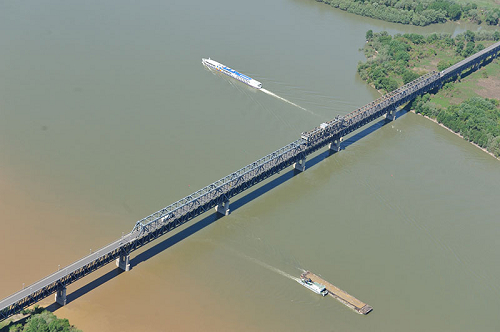The bridge where two alphabets meet
The bridge over the Danube between the Bulgarian city Ruse and the smaller Romanian city of Giurgiu is more than just a way to cross a large European river. Called the Friendship Bridge, it symbolises two countries rediscovering each other. It also marks where two of Europe’s alphabets meet. On the Romanian side the Latin alphabet holds sway, while on the Bulgarian side everything is expressed using the Cyrillic script.

The friendship bridge
If you stand on the bridge and look to the higher bank, you will catch a glimpse of Ruse's beauty. A walk across the streets of Bulgaria's largest city on the Danube will explain why it is called "Little Vienna". With its magnificent architectural cocktail of baroque, rococo, and art nouveau, the centre of Ruse illustrates the architectural waves that came from Western Europe in the late 19th and early 20th century.
Looking from the bridge to the other side, you will see the port of Giurgiu. Unlike Ruse, this Romanian city is located further away from the river banks. Once you are there, it is worth having a stroll through its calm streets, visiting the historical museum "Teohari Antonescu" and the church, "Sfântu Gheorghe", or enjoying a cup in cafés near the clock tower on the central square.
Before the two countries joined the EU in 2007, the Danube formed a border. It constitutes a meeting point for interlocking cultures. The increased contacts have provoked a mutual interest in the language of the neighbouring country. "When they started to learn our language , Romanians remembered that their ancestors wrote in Cyrilic in the past, and Bulgarians realised how many similar words there are in the two languages," said Dr Mimi Kornazheva, the director of the Bulgarian- Romanian Interuniversity Europe Center (BRIE). The school is unique in south-east Europe and the training during the first two semesters takes place both in Ruse and Giurgiu. The aim is that Bulgarian students learn Romanian and Romanians Bulgarian.
BRIE is currently working on an EU-funded study on cross-border identity. The first conclusions are that in an effort to get to know each other and become closer, the residents of border regions develop a new identity in a natural way that helps to overcome their differences.
The local administrations are now working on a project to transform Ruse and Giurgiu into an integrated city. The project benefits from €950,000 in funding from the European Regional Development Fund. Plans include building an urban rail between Ruse and Giurgiu, opening a business incubator which would create 10,000 jobs , the construction of two new modern living areas and last but not least, the construction of a second bridge over the Danube between Ruse and Giurgiu .
The renewed cooperation is a reflection of a common past. Until the middle of the 19th century the Cyrilic alphabet was also in use in Romania, while worship was performed in the Church Slavonic language up until the 18th century, with many local churches having preserved inscriptions with the letters of the script created by the brothers Cyril and Methodius in the 9th century.
Source: European Parliament
- 277 reads
Human Rights
Ringing FOWPAL’s Peace Bell for the World:Nobel Peace Prize Laureates’ Visions and Actions

Protecting the World’s Cultural Diversity for a Sustainable Future

The Peace Bell Resonates at the 27th Eurasian Economic Summit

Declaration of World Day of the Power of Hope Endorsed by People in 158 Nations

Puppet Show I International Friendship Day 2020

